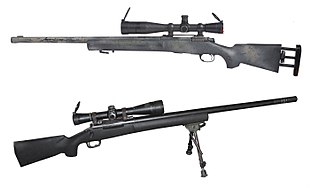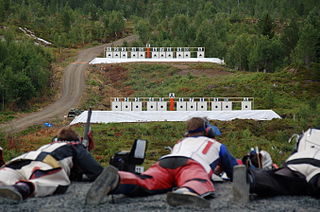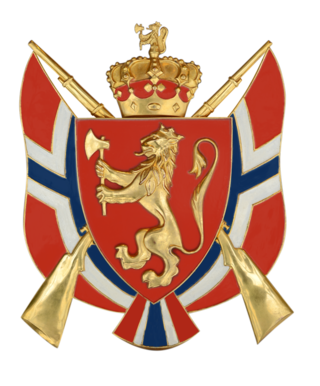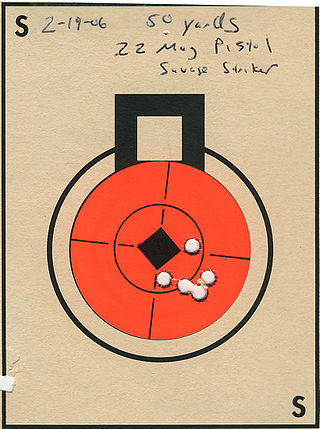
A minute of arc, arcminute (arcmin), arc minute, or minute arc, denoted by the symbol ′, is a unit of angular measurement equal to 1/60 of one degree. Since one degree is 1/360 of a turn, one arcminute is 1/21600 of a turn. The nautical mile (nmi) was originally defined as the arc length of a minute of latitude on a spherical Earth, so the actual Earth circumference is very near 21600 nmi. A minute of arc is π/10800 of a radian.

The biathlon is a winter sport that combines cross-country skiing and rifle shooting. It is treated as a race, with contestants skiing through a cross-country trail whose distance is divided into shooting rounds. The shooting rounds are not timed per se, but depending on the competition, missed shots result in extra distance or time being added to the contestant's total.

Shooting sports is a group of competitive and recreational sporting activities involving proficiency tests of accuracy, precision and speed in shooting — the art of using ranged weapons, mainly small arms and bows/crossbows.

A sniper rifle is a high-precision, long-range rifle. Requirements include high accuracy, reliability, and mobility, concealment, and optics, for anti-personnel, anti-materiel and surveillance uses by military snipers. The modern sniper rifle is a portable shoulder-fired rifle with either a bolt action or semi-automatic action, fitted with a telescopic sight for extreme accuracy and chambered for a high-ballistic performance centerfire cartridge.

A milliradian is an SI derived unit for angular measurement which is defined as a thousandth of a radian (0.001 radian). Milliradians are used in adjustment of firearm sights by adjusting the angle of the sight compared to the barrel. Milliradians are also used for comparing shot groupings, or to compare the difficulty of hitting different sized shooting targets at different distances. When using a scope with both mrad adjustment and a reticle with mrad markings, the shooter can use the reticle as a ruler to count the number of mrads a shot was off-target, which directly translates to the sight adjustment needed to hit the target with a follow-up shot. Optics with mrad markings in the reticle can also be used to make a range estimation of a known size target, or vice versa, to determine a target size if the distance is known, a practice called "milling".

Stadiametric rangefinding, or the stadia method, is a technique of measuring distances with a telescopic instrument. The term stadia comes from a Greek unit of length Stadion which was the typical length of a sports stadium of the time. Stadiametric rangefinding is used for surveying and in the telescopic sights of firearms, artillery pieces, or tank guns, as well as some binoculars and other optics. It is still widely used in long-range military sniping, but in many professional applications it is being replaced with microwave, infrared, or laser rangefinding methods. Although much easier to use, electronic rangefinders can give away the shooter's position to a well-equipped adversary, and the need for accurate range estimation existed for much longer than electronic rangefinders small and rugged enough to be suitable for military use.

The Mad Minute was a pre-World War I bolt-action rifle speed shooting exercise used by British Army riflemen, using the Lee–Enfield service rifle. The exercise formally known as "Practice number 22, Rapid Fire, The Musketry Regulations, Part I, 1909", required the rifleman to fire 15 rounds at a "Second Class Figure" target at 300 yd (270 m). The practice was described as; "Lying. Rifle to be loaded and 4 rounds in the magazine before the target appears. Loading to be from the pouch or bandolier by 5 rounds afterwards. One minute allowed".
The SIG Sauer 200 STR, also known as the SIG Sauer 200 STR Match, is a bolt-action rifle mostly used as a target/competition rifle for national competitions by Norwegian, Swedish and Danish sport shooters. It is a variant of the Sauer 200 TR or SIG Sauer 200 TR Match rifle that features thicker 19 mm (0.75 in) diameter barrels. The 200 STR is produced by J. P. Sauer & Sohn GmbH in Germany.

A red dot sight is a common classification for a non-magnifying reflector sight that provides an illuminated red dot to the user as a point of aim. A standard design uses a red light-emitting diode (LED) at the focus of collimating optics, which generates a dot-style illuminated reticle that stays in alignment with the weapon the sight is attached to, regardless of eye position.

Dynamic Sports Shooting Norway (DSSN), NorwegianDynamisk Sportsskyting Norge (DSSN), is the Norwegian association for practical shooting under the International Practical Shooting Confederation. It was constituted in 1979 as Norges Forbund for Praktisk Skyting (NFPS), and changed its name to Dynamisk Sportsskyting Norge in 2013.

Steel targets are shooting targets made out of hardened (martensitic) steel, and are used in firearm and airgun sports such as silhouette shooting, cowboy action shooting, practical/dynamic shooting, long range shooting and field target, as well as recreational plinking. They are popular in both training and competitions because the shooter gets instant acoustic feedback on a successful impact, and can often also visually confirm hits by seeing the bullet getting pulverized, leaving a mark on the surface paint, or moving/knocking down the target. Hanging steel plates or self-resetting steel targets also have the advantage that the shooter does not need to go forward downrange to tape the targets, making it a good option for shooting ranges that otherwise have electronic targets. Steel targets also are weatherproof, contrary to paper targets, which do not hold up in rain and wind gusts.

Long range shooting is a collective term for shooting disciplines where the distance to target is significant enough that shooter has to put effort into calculating various ballistic factors, especially in regards to the deviating effects of gravity and wind. While shooting at shorter ranges, a shooter only has to slightly adjust the sights to compensate for limited bullet drop at most, but when the range is extended, wind drift will be the first factor affecting precision to the extent that it must be taken into serious account. Some would argue that long range shooting starts where assessment of wind, distance and various atmospheric conditions are equally important for the results as pure shooting skills - meaning that even if one conducts a technically perfect shot, the shooter will miss the target because of incorrect calculations, neglecting to take some elements into consideration, or merely due to unpredictable downrange conditions. It is widely accepted within interdisciplinary circles that for a standard rifle firing full-powered cartridges, "long range" means the target is more than 600 m (660 yd) away,, while "extreme long range" is generally accepted as when the target distance is more than 1,000 m (1,100 yd) away from the shooter.

Stangskyting, literally Stang-shooting named after Colonel Georg Stang (1858–1907), is a practical rifle competition popular in Norway where dueling shooters have two periods of 25 seconds to get as many hits as possible on a target at an unknown distance, with an unlimited number of rounds. Competitions in Norway are arranged by Det frivillige Skyttervesen.

Det frivillige Skyttervesen (DFS), known in English as the National Rifle Association of Norway, and by DFS themselves as the Norwegian Civilian Marksmanship Association since 2020, is a civilian marksmanship association in Norway and the largest shooting sport organization in Norway. It was created in 1893 by Norway's Storting to promote practical shooting skills within the Norwegian people, thereby empowering the national defence. DFS is sponsored by the Norwegian parliament and receives annually about 30 million Norwegian krones to fulfil their purpose. DFS collaborates with various departments in the Norwegian Armed Forces by educating shooting instructors. They also lend their shooting ranges for free to the Norwegian Home Guard. DFS is under the patronage of Harald V of Norway.

In shooting sports, a shot grouping, or simply group, is the collective pattern of projectile impacts on a target from multiple consecutive shots taken in one shooting session. The tightness of the grouping is a measure of the precision of a weapon, and a measure of the shooter's consistency and skill. On the other hand, the grouping displacement is a measure of accuracy.

The International T-Class Confederation (ITCC), founded in 2014, promotes the shooting sport of T-Class which is mainly focused on competitions with precision rifle systems for various short, medium and long range distances, which may either be known or unknown. Headquarters reside in Bulgaria, and for the purpose of promotion of the sport internationally the organization offers a ruleset which regulates the design and management of competitions.
Nordic field biathlon is a combined cross-country skiing and shooting sport discipline within Det frivillige Skyttervesen. The sport is considered a close predecessor to olympic biathlon, with the main difference being the use of fullbore biathlon rifles and paper targets placed in the terrain with time penalties added for misses. The skiing is usually performed in classic style, while freestyle on is permitted in some races. The number of shots and length of the skiing part can vary. Contrary to the other exercises in the organization, Nordic shooting with cross-country running and Nordic Field Biathlon competitors are divided into male and female competitive divisions.

Anschütz 1827 Fortner is a straight-pull action biathlon rifle designed by Peter Fortner junior and produced in cooperation with J. G. Anschütz. The rifle has been dominant in the sport of biathlon since the late 1980s, and is the current sport standard. It is estimated to be used by 97% of biathlon competitors worldwide. About 7000 had been manufactured by 2007.

International Benchrest Shooters (IBS) is as a governing body for benchrest shooting that is mainly active in the USA.

Biathlon orienteering or orienteering shooting is a multisport consisting of shooting and orienteering. The sport is organized internationally by the International Biathlon Orienteering Federation (IBOF), and is mainly practiced in the Nordic countries as well as a few other European countries. Competitions are organised in Denmark by Danish Military Sports Association (DMSA), in Sweden by the civilian Swedish Multisport Association and in Finland by the Finnish Reservist Sports Federation (FRSF).





















